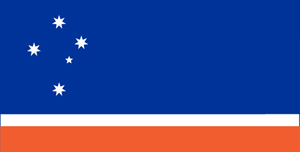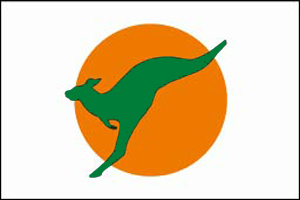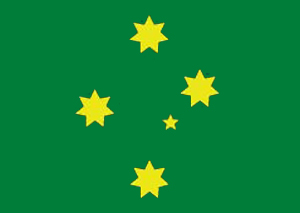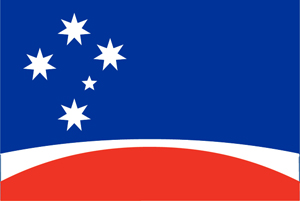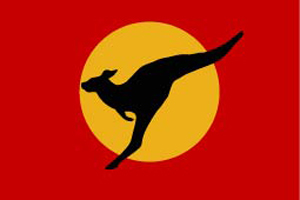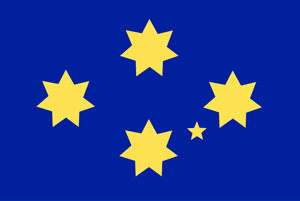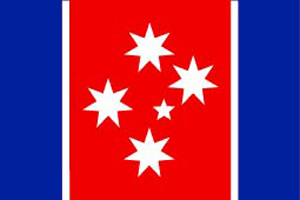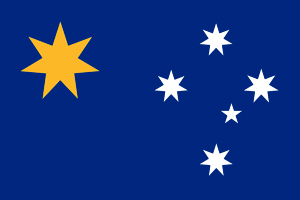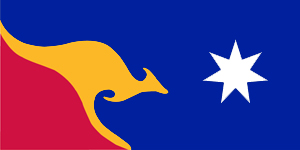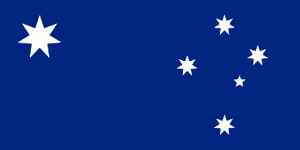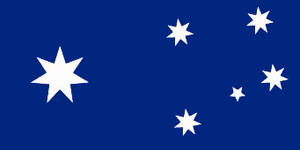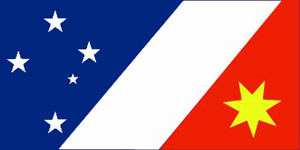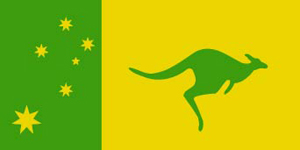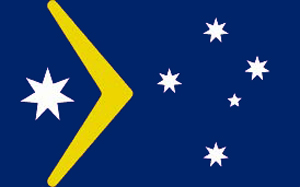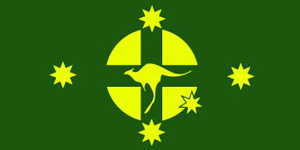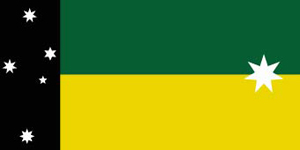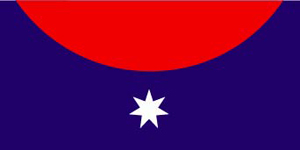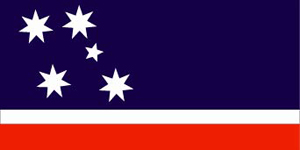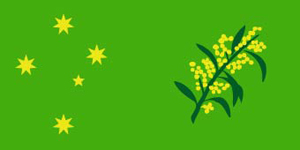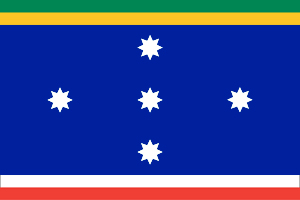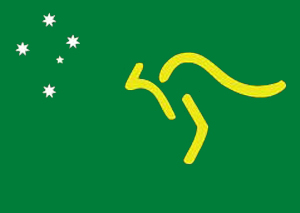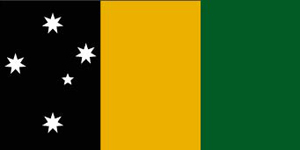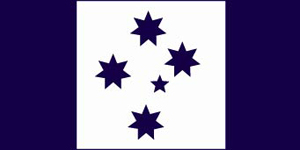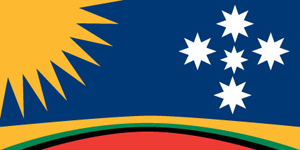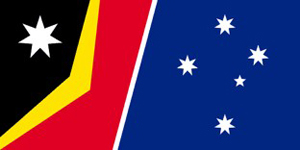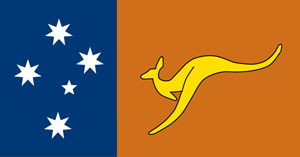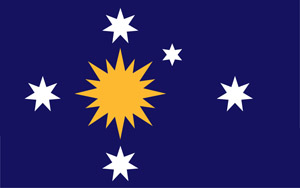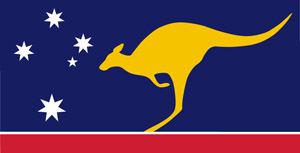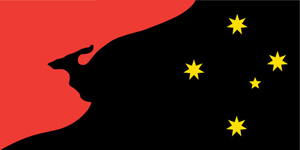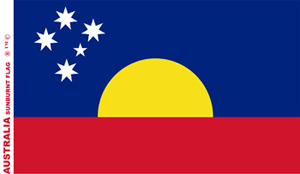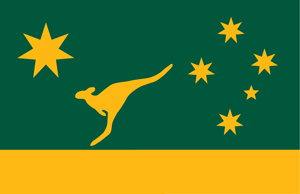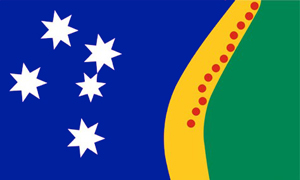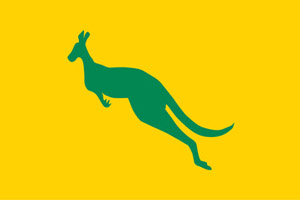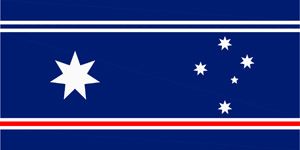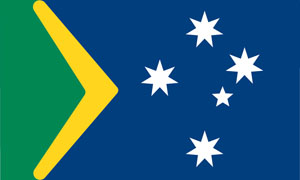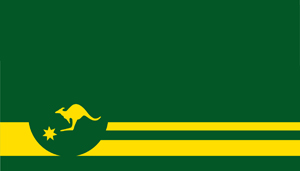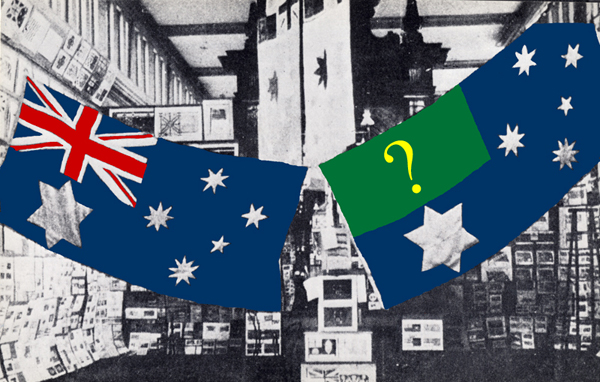 |
||||||||||||||||||||||||||||||||||||||||||||||||||||||||||||||||||||||||||||||||||||||||||||||||||||||||||||||||||||||||||||||||||||||||||||||||||||||||||||||||||||||||||||||||||||||||||||||||||||||||||||||||||||||||||
|
Should Australia have a new flag?
Australia is one of the few countries in the
world where a change of the design of the national flag is advocated.
National flags do change over time, usually reflecting a major change in
the country's constitutional arrangements or government. Advocates of
change in Australia believe that another flag design would be more
effective in representing Australia than the current flag. Such
proposals for change are rejected for two broad reasons - the status quo
should endure because the case for change is not accepted and the
national flag is symbolic of the nation and it should be honoured
without alteration. Many supporters of the national flag do not make any
distinction between the flag and the nation - they display the flag to
demonstrate their patriotic support for Australia. Advocates of change
claim to be equally patriotic, they only want to have a different flag
to use.
The issue of a potential change is one that
Flags Australia takes a strong interest in but, reflecting the mix of
personal views of its members and a desire to be non-political, Flags
Australia does not, as an entity, have an opinion - it neither supports a
change of flag nor does it oppose such a change. It is however
considered appropriate that Flags Australia provides expertise and a
forum for debate and it fully reports both proposals for change and the
views of advocates for the current flag. Flags Australia strives for
balance in its coverage of the issue but does not resile from the view
that the debate should be conducted with maximum respect and the
arguments on both sides should be soundly based on correct facts about
the history of flags in Australia and good design principles as they
apply to flags. Emotions and politics legitimately play a role in
connection with flags and ultimately the Australian political processes
will determine the course of the flag debate.
The main arguments advanced in respect of a new
flag, for and against, are summarised below. The text seeks to clearly
express in summary form the opinions of each side of the flag debate,
though neither text represents the views of Flags Australia. The texts
have not been reviewed or authorised by either ANFA or Ausflag.
Retain the current Australian Flag
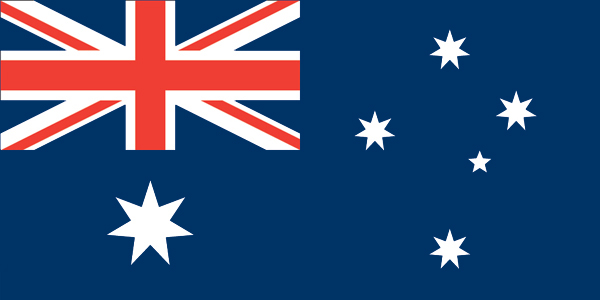
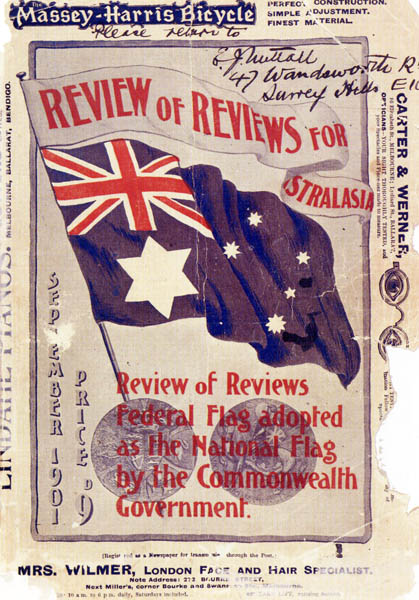
Further information can be obtained from the website of the Australian National Flag Association.
Australia Needs a New National Flag
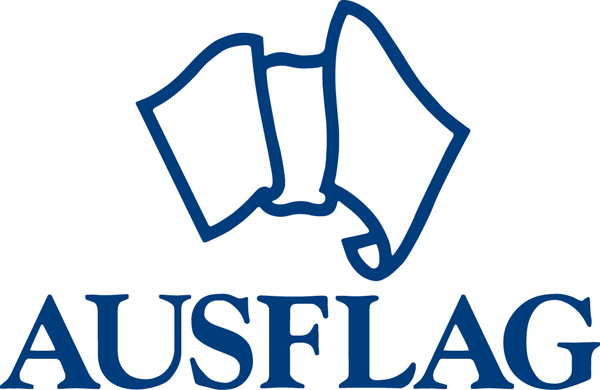
There have been a number of proposals to change
the design of the national flag. In addition to the high profile Ausflag
Limited there are also a number of individuals who have designed and
promoted their own personal vision for a new flag. Set out below is an
amalgam of the various arguments put forward as to why Australia should
have a new flag.
Further information can be obtained from the website of Ausflag Limited
Ausflag has regularly promoted alternative flag
designs including the holding of public design competitions. A number of
the flags that Ausflag has promoted are:
A number of other Australians have proposed new
designs for an Australian national flag. A selection of these designs,
most of which have been featured in Crux Australis, is listed
below. More information on many of the more recent flag proposals can
also be found on the web sites of their designers.
|
Wednesday, 4 December 2013
Should Australia have a new flag?
Some of the Significant Historical Flags of Australia
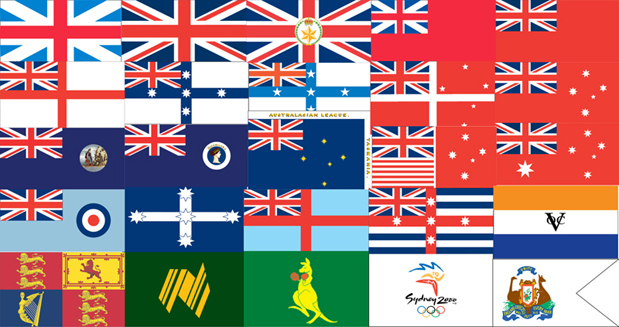
Some of the Significant Historical Flags of Australia
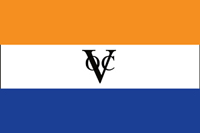 |
Dutch explorers - The first documented European contact with Australia was by Captain Willem Janszoon who, in 1606, captained the Duyfken when it sailed from Java to what is now known as Cape York. In 1616 Dirk Hartog landed on the Western Australian coast, whilst in 1642 Abel Tasman mapped Van Diemen's Land (later renamed Tasmania). These and other Dutch explorers were in the service of the Dutch East India Company (Vereenigde Oostindische Compagnie), whose flag was the Dutch triband with the initials VOC in the centre. Initially the top stripe of the Dutch flag was orange, but by 1660 it had become the red of the current Dutch flag. | |
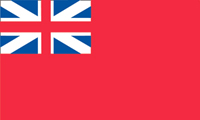 |
Red Ensign (1707-1800) - Lieutenant James Cook on HM Bark Endeavour on his first voyage of discovery was the first European to explore the east coast of Australia. He landed at Kurnell on Botany Bay on 29 April 1770. The Endeavour was in the service of the Royal Navy, but as it was not attached to any fleet, it flew the British Red Ensign (one of three flags then used by the Royal Navy). | |
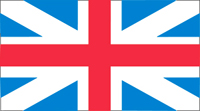 |
Union Jack (1606-1800) - At Possession Island in the Torres Strait, Lieutenant James Cook raised the British flag on 22 August 1770, claiming the entire eastern coastline of Australia as British territory. On 26 January 1788 Captain Arthur Phillip established the first European settlement in Australia at Sydney Cove. The location of the landing and first flag raising is today commemorated with a flagpole in Loftus Street, Sydney. The Union Jack was created on 12 April 1606, three years after King James VI of Scotland ascended the English throne as King James I. The flag combined the traditional | |
| English St. George's Cross with the Scottish St. Andrew's Cross. It is correct to describe the flag as the Union Jack, but it can more formally be called the Union Flag. The name Queen Anne flag is erroneous. | ||
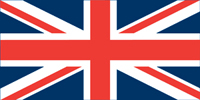 |
Union Jack 1801 - The Act of Union 1801
merged Ireland with the Kingdom of Great Britain (which was formally
created by the union of England and Scotland in 1707) to create the
United Kingdom of Great Britain and Ireland with effect from 1 January
1801. The Union Jack was modified to reflect this constitutional change
by adding a Cross of St. Patrick to represent Ireland. A red diagonal
cross on a white field has never been the traditional flag of Ireland
nor even associated with St Patrick prior to 1801. Its use seems to have
been only a heraldic convenience. The emblem had been used on some
Irish coats of arms, including those of the FitzGerald family, early
Royal representatives in Ireland. The traditional emblem of Ireland is a
golden harp on a blue or green background; when a female figure is
added to the fore-pillar of the harp it is called the Maid of Erin.
In Australia, the Union Jack was the sole
official flag for use on land until Federation. After the creation of
the Australian flag, the Union Jack continued to be regarded as the
national flag of Australia, though gradually such usage was shared with
the Australian red ensign, and later with the Australian blue ensign.
The Flags Act 1953 has a clause that authorises the continued use of the Union Jack in Australia, though its usage has declined from the 1970s.
|
|
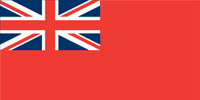 |
Red Ensign 1801 - The British red ensign was altered in 1801 to include the change to the design of the Union Jack. British legislation required, with a few exceptions, that all merchant shipping throughout the British Empire fly the British Red Ensign, without any defacement or modification. The ensign is sometimes referred to as the red duster. The Royal Navy stopped using the Red Ensign in 1864. | |
 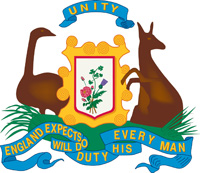 |
Bowman Flag - The oldest known locally designed flag in Australia was created by John and Honor Bowman in 1806. It was flown from their home near Richmond, NSW to celebrate news of the victory of Lord Horatio Nelson at the Battle of Trafalgar on 21 October 1805. As the Royal Navy fleet moved towards engagement with a combined French and Spanish fleet, he hoisted signal flags that spelled out England expects that every man will do his duty. This famous phrase was embroidered onto a silk flag that included a shield featuring a rose, thistle and shamrocks. The use of the kangaroo and emu as supporters for the shield is the first known use of these animals as symbols of Australia. The original of the Bowman flag is in the collection of the State Library of NSW. | |
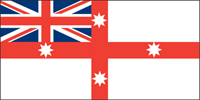 |
National Colonial Flag - Captain John Bingle, a former mariner, wrote his memoirs in 1881 in which he stated that Captain John Nicholson and he had designed a flag for use as a national colonial flag for Australia. He claimed that the flag had been approved by NSW Governor Sir Thomas Brisbane in 1823, though no other record of the flag or any approval has been found. The flag has been promoted as the earliest Australian flag and the first use of the Southern Cross on a flag. The image is of a reconstruction of the flag by Sydney vexillologist, John Vaughan, based on an interpetation of Bingle's written description. | |
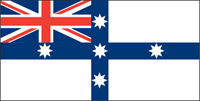 |
NSW Ensign / Australian Ensign - A flag chart contained in an 1832 book, New South Wales Calendar and General Post Office Directory included a flag that was captioned N.S.W. Ensign. It shows a white British ensign with a blue cross overall upon which are five 8-pointed stars. This flag is believed to have been widely used as a local merchant shipping flag in Sydney and on the east coast of Australia, becoming known as the Australian Ensign. The flag however | |
| was unofficial and in 1883, the British Admiralty prohibited its continued use by vessels due to its claimed similarity to the Royal Navy's White Ensign. | ||
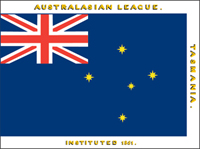 |
Anti-transportation League - Formed in Launceston to oppose the transportation of convicts to Australia, the Australasian League for the Abolition of Transportation had established branches in several colonies by 1851. At a meeting in Melbourne a large flag was unfurled - it was a British blue ensign upon which were four golden stars forming the Southern Cross. This is the first known flag using the Southern Cross in a natural arrangement and it is considered to be a significant antecedent to the current Australian National Flag. The original flag is in the collection of the Queen Victoria Museum and Art Gallery, Launceston. The League was dissolved when transportation to Tasmania ended in 1853. | |
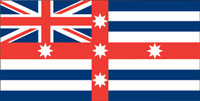 |
Murray River Flag - The first paddle-steamer went into service on the Murray River in 1853 and a flag called the Murray Flag was flown in its honour. Though the flag was used by many of the paddle steamers, no example has survived and there are no contemporary illustrations. The flag was described by a 1854 journalist's report as "it bears a red cross with four horizontal bars of blue, the cross being charged with five stars as emblems of the different Australian colonies". The illustration represents a reconstruction by Frank Cayley in 1966. The flag continues to be used by craft on the Murray River, including several historic paddle steamers and more modern tourist boats. A different version of the Murray River Flag is promoted in South Australia, based on an alternate interpretation of the contemporary description. | |
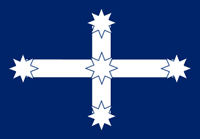 |
Eureka Flag - Gold
miners in Ballarat, Victoria protested about various grievances, which
led to the short-lived Eureka rebellion of 1854. At a meeting of 12,000
miners on 29 November 1854 a new flag was raised as a gesture of
defiance against the Victorian Government. The Eureka Flag was
dark blue with five stars representing the Southern Cross, the stars
joined together by a broad white cross. The rebellion ended on 3
December 1854 with colonial troops and police storming the Eureka
Stockade and hauling down the flag from the pole erected there as a
rallying point.
The Eureka Stockade and its flag have
become historical symbols of the wider struggle by Australians for
democracy and national identity. The original flag was re-discovered in
the early 1960s and is now on public display at the Ballarat Fine Art
Gallery. The Eureka Flag continues to evoke strong feelings and it has
been used to support a variety of political and trade union causes. In
deference to its authentic Australian heritage, some Australians
advocate that the Eureka Flag become the Australian national flag.
|
|
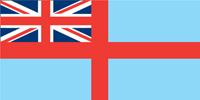 |
Queensland Separation Flag - A separate colony of Queensland was established on 10 December 1859. Separation from New South Wales was celebrated by the flying of a new flag - the Queensland Ensign, which has become known as the Queensland Separation Flag. Only a written description exists - "a light blue flag with a red St George's Cross and union in the corner"; the illustration represents a reconstruction. It is unclear for how long the flag was used. The flag continues to be flown at Newstead House in Brisbane. | |
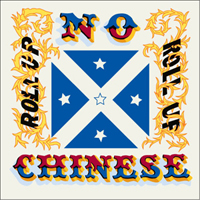 |
Lambing Flat - Strikes and unemployment on the goldields in southern NSW in the early 1860s were the catalyst for violence and riots directed against immigrant Chinese labourers. One of the worst disturbances was at Lambing Flat (now Young) where, on 30 June 1861 miners attacked the Chinese quarter killing and wounding several labourers. A public meeting of miners had been advertised by a banner painted on the side of a tent. At its centre was a Scottish St. Andrews Cross with four white stars. It is possible that this emblem was intended to refer to the Eureka Flag with its white cross and stars of the Southern Cross. Despite the harshness of the "No Chinese" slogan, this remains an important historical relic. Painted on canvas, it is not a flag strictly, but isconsidered significant in showing the early emergence of the Southern Cross as an Australian symbol. The banner is on display at the Lambing Flat Folk Museum, Young. | |
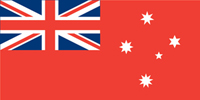 |
Victorian red ensign -
On 1 February 1870 Victoria adopted two flags - a blue flag with the
Southern Cross for use by the first Australian colonial warship (HMCS Nelson)
and a red version for use by the mercantile marine. The Victorian Red
Ensign was approved by the British Board of Trade, even though this was
contrary to the normal practice that colonial shipping was required to
use the British Red Ensign without a badge. It was used (without any
crown) until 1903 and it came to be flown on land, particularly in the
lead-up to Federation.
This red ensign was a clear antecedent of
the winning design in the 1901 competition for an Australian flag. The
Australiian flag design was merely the Victorian Red Ensign with the
addition of the six-pointed Federal Star. It should be noted that the
arrangement of stars was 9,8,7,6 and 5-pointed and the badge extended
over the full area of the fly of the flag - identical to the layout of
the winning Australian design (though the stars on the blue Victorian
state flag had altered to 8,7,7,6 and 5 points in 1876).
|
|
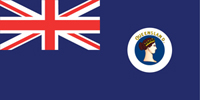 |
Queensland 1870 - The badge for the first flag for Queensland was adopted on 22 March 1870 by Governor Samuel Blackall. It consisted of a portrait of the young Queen Victoria crowned with the Diamond Diadem together with the inscription Queensland. The badge clearly attests that the colony had been named in honour of the Queen. However it was difficult to produce on bunting a fair representation of the head of Her Majesty and the decision was made in 1876 to replace the badge with the current design. | |
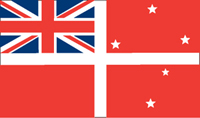 |
Tasmanian Colonial Flag - On 9 November 1875, the Tasmanian government proclaimed a new Colonial Flag for use by local ships. It was a British red ensign with the addition of a white cross overall and the Southern Cross. However, it was revoked on 23 November - only 14 days later - when it was realised that the flag was contrary to British Admiralty rules for colonial flags. The flag however did have some continued existence - on the label of Cascade Brewery's Sparkling Pale Ale beer during the 1920s through to the 1940s. | |
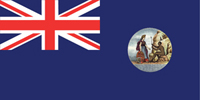 |
South Australia 1876 - The British Admiralty rules required that the colonial flags be the British Blue Ensign with a badge consisting of the public seal of the colony or some other drawing to represent the colony. In 1870 Victoria, NSW, New Zealand and South Australia each submitted to London badge designs that featured the Southern Cross. In response to criticism from the British Admiralty, on 24 March 1876 South Australia decided to use its seal on the flag. This was a complex allegorical scene of Britannia meeting an Australian Aboriginal seated on a rock on a beach. This flag was in use until 1904 when it was replaced by the current design. | |
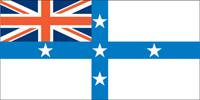 |
Federation Flag - In the mid-1880s efforts to join the separate Australasian colonies into an Australian federation increased. The earlier Australian Ensign was revived for use on land and in printed materials to promote federation, particularly in NSW and Queensland. In the absence of an official Australian flag in January 1901, this Federation Flag was widely used. When Prime Minister Edmund Barton submitted the winning design in the Federal flag competition to the British authorities in 1902, he also included the Federation Flag as Design B - an alternative for adoption as the new Australian national flag. It was rejected without any consideration as it did not conform to the style of official British flags. Usage as an unofficial Australian flag continued until Word War I. | |
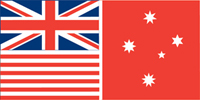 |
Herald Federal Flag - With Federation approaching questions arose as to what the flag of a federated Australia should be. In 1900 the Melbourne Evening Herald newspaper conducted a public competition for a Federal Flag. Mr F. Thompson won the £25 prize and the flag has become known as the Herald Federal Flag. Federation was symbolised with six red stripes below the Union Jack and Australia was represented by the Southern Cross. Two versions were created, one with the Southern Cross on a blue background for use by the Government and another for general use with a red backgound. The design was both praised and criticised, leading to another competition by the Review of Reviews for Australasia magazine that was later incorporated into the Federal Government's flag design competition in 1901. | |
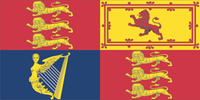 |
Royal Standard 1901 - The inauguration of the Commonwealth of Australia took place on 1 January 1901, with the formal ceremony in Centennial Park, Sydney. As there was no official Australian flag, this and other celebrations were marked with the use of the Federation Flag, the Victorian Red Ensign and the Union Jack. Above the Swearing-in-Pavilion, the flag flown was the British Royal Standard, marking the presence of the Governor-General, the Earl of Hopetoun. | |
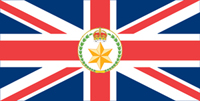 |
Governor General 1903 - A flag for the Governor-General was adopted in 1903 in the usual form for colonial governors. It was a Union Jack with a central disc containing the badge of Australia - a six pointed star surmounted by a crown. Initially, the Governor-General was the representative of the British Government in Australia and all major correspondence between the Australian Government and Britain passed through the office of the Governor-General. The Statute of Westminster 1931 changed the relationship between the Dominions and Britain and this was reflected by the appointment of a separate British High Commissioner in 1931 and a change in the flag of the Governor-General in 1936. | |
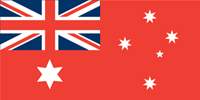 |
Australia: People's Flag
- The 1901 flag competition winning design was announced on 3 September
1901 and the selected design was subsequently modified and formally
adopted from 20 February 1903, with a further change to the current
design from 23 February 1908. Initially the blue version of the
Australian flag was limited to government use and the red was only
intended for use by private shipping. At sea the use of the Union Jack
was prohibited except on warships of the Royal Navy and there was
uncertainty as to whether ordinary people could use the Union Jack on
land.
The practice developed during the 19th
century in Britain and other parts of the Empire for the British Red
Ensign to be used on land when private citizens wanted to fly a flag
from a building. This practice explains why the flag of Canada until
1965 was a red ensign. Accordingly, the Australian Red Ensign was the
flag used when businesses and individuals wanted to fly a local flag,
either in addition to or in place of the Union Jack. The Australian
Red Ensign historically can be considered to be the People's Flag, though there was no contemporary use of this description.
|
|
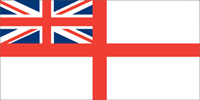 |
British White Ensign - The Royal Australian Navy was formally established in July 1911. The first Australian warships, HMAS Parramatta and HMAS Yarra, were built in Scotland and arrived in Australia in December 1910. A Naval Conference between the British Admiralty and Australia determined in June 1911 that Australian warships would fly the White Ensign of the Royal Navy as their principal flag. When warships are in port, an additional flag is flown on the jackstaff - this was the blue Australian National Flag. The British White Ensign was used by the Royal Australian Navy until 1 March 1967 when the Australian White Ensign came into use. | |
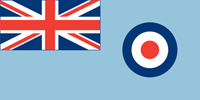 |
RAF Ensign - The Royal Australian Air Force was established in 1921. In March 1922 the RAAF's Air Council decided that the flag of the Royal Air Force would be used in Australia. A proposal to use a flag that included the Commonwealth Star and added the Southern Cross to the roundel had been rejected by the British authorities. A distinctive ensign for the RAAF was not adopted until 1949. | |
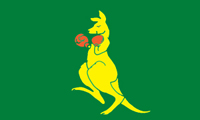 |
Boxing Kangaroo - In 1983 the yacht Australia II won the America's Cup in Newport, Rhode Island - a sporting achievement that inspired the nation. The promotional mascot for the challenge was the Boxing Kangaroo - a cartoon of a kangaroo wearing boxing gloves. This irreverent symbol was placed upon a green flag and it become symbolic of national pride and enthusiasm for Australian achievement in many fields of endeavour. Subsequently the copyright to the image was purchased by the Australian Olympic Committee and it continues to be used in sports promotions. An earlier example of a boxing kangaroo image is from World War II when it was painted onto the fuselage of some RAAF aircraft. | |
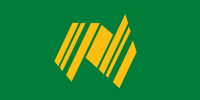 |
Bicentennial Flag - The 200th anniversary of European settlement in Australia was celebrated on 26 January 1988. The logo for the Bicentennial celebrations was a stylised map of Australia, consisting of a ribbon with stripes of different widths. The ribbon alluded to the diagonal stripes of the Union Jack and the seven golden stripes signified the six states and the territories. The logo was initially placed on a blue field to create a flag, but this was changed to green in 1984 after green and gold were declared the national colours of Australia. | |
| Centenary of Federation Flag - The 100th anniversary of Federation - the establishment of the Commonwealth of Australia, was celebrated on 1 January 2001. The logo for the Federation Centenary celebrations was a stylised map of Australia, consisting of a ribbon of various colours. The ribbon colours alluded to the Australian landscape. The use of an eight-pointed Federation star caused some confusion, with the additional point representing the Commonwealth, additional to the six states and the territories. Some versions of the flag added a coloured bar at the top and bottom to relieve the plainness of a white field with a mostly white logo. The use of text to explain the logo highlighted its inadequacies as a graphic design. | ||
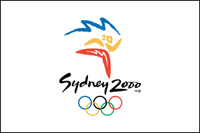 |
Sydney Olympics - The 2000 Summer Oympics were held in Sydney over 16 days from 15 September. The logo of the Sydney Organising Committee for the Olympic Games (SOCOG) was placed on a white background to create a Sydney 2000 flag. The general public however was not allowed to own Olympic flags, so usage was limited to Olympic venues and public sites. The logo was incorporated into a vast array of souvenirs and other merchandise sold over the four years prior to the Games. The logo was described as the Millennium Athlete - a running man made from stylised boomerangs. | |
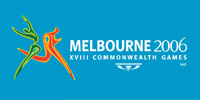 |
Melbourne Commonwealth Games - The Eighteenth Commonwealth Games were held in Melbourne from 15th to 26th March 2006. The central design of the logo of the Games consisted of two stylised athletes forming the letter M representing movement and the host city. The colours represented the Australian landscape - earth red and rainforest green and the duality reflected the Melbourne passion for both sport and culture. The flag and logo appeared all over Melbourne and on handwaver flags. Athletes from 71 countries and territorites of the Commonwealth of Nations attended these Games. |
Subscribe to:
Comments (Atom)
